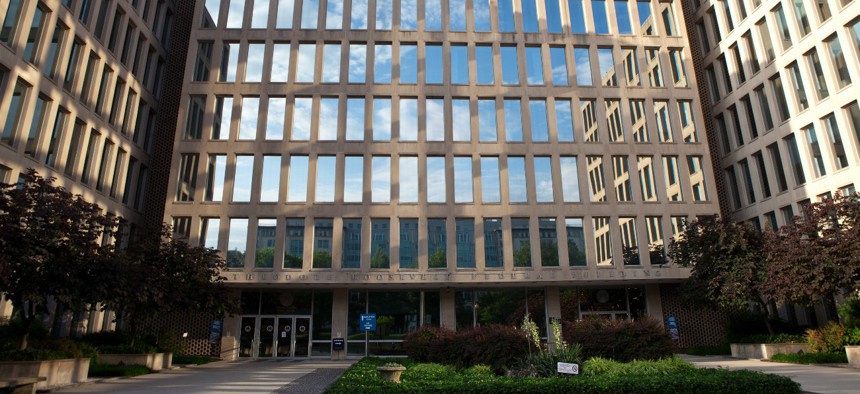OPM Is Reorganizing Employees to Get Around Ban on GSA Merger, Union Claims
Over the weekend, the Office of Personnel Management moved nearly two dozen employees into the agency’s HR Line of Business, which is being renamed with GSA support.
A union representing employees at the Office of Personnel Management is accusing the agency of improperly reorganizing workers without bargaining over the change and potentially violating a ban on merging OPM with the General Services Administration.
On July 24, OPM informed officials at the American Federation of Government Employees Local 32 that it would be moving 22 bargaining unit employees from the Office of Strategy and Innovation and the Office of the Chief Information Officer’s Federal Data Solutions to the HR Line of Business, which would in turn be renamed Human Capital Data Management and Modernization. The reorganization went into effect Sunday.
OPM denied demands from AFGE to bargain over the change, arguing that the reorganization meets procedures set out in their contract that allow the agency not to consult with labor representatives.
“As indicated above, the reorganization will not result in a change of conditions of employment for the bargaining unit employees and to the extent to which there is a change, any such change will be de minimis,” wrote Anne Mortenson, employee and labor relations manager for OPM human resources. “Employees will remain on the same position descriptions and under the same performance standards. As the new organizations commence their work, employees may receive some new assignments consistent with their current duties and consistent with their performance standards and position descriptions.”
But AFGE Local 32 President Marlo Bryant-Cunningham said that the union disagrees with that assessment. She said employees have noticed a significant presence from GSA officials in the new team, and that employees’ duties appear to be subject to change. AFGE has filed an internal grievance against the agency following OPM’s refusal to bargain over the change.
“The employees are fearful of being asked to do things that aren’t quite legal,” Bryant-Cunningham said. “[OPM HR Line of Business Director] David Spinale, the political appointee over this group, ... brought in another political appointee as a senior adviser, and she’s responsible for rewriting everyone’s position descriptions to align with the work they’ll do in the group, even though HR normally rewrites [position descriptions].”
The potential that a political appointee would be rewriting the descriptions rather than career HR employees concerns the impacted employees because their duties could be changed so that they no longer qualify for their jobs or the new description could pull them out of the union altogether.
The presence of GSA officials, particularly GSA Data Strategist Marcel Jemio, who previously served as chief data architect at OPM, within the new Human Capital Data Management and Modernization group raised alarm bells for the reorganized employees, Bryant-Cunningham said.
“We’ve been told that GSA, who already had a presence at HR [Line of Business], will provide systems services, and from what employees have said, their work is heavily influenced by GSA,” she said. “GSA is working on this new thing called New Pay, surrounding pay and leave policy and payroll policy. Normally, anything that deals with those topics would still come out of OPM, but they seem to be merging this function to create New Pay with this group.”
GSA spokeswoman Pamela Penninton said GSA's work on New Pay, and the agency's engagement with OPM, is strictly focused on developing payroll technology.
"New Pay has had a longstanding partnership with the HR [Line of Business] to design and develop government-wide data standards for payroll and time and attendance related to the design and configuration of the payroll/[Work Schedule Leave Modernization] technology solution," she said. "The features that are being developed have been done so in conjunction with HR [Line of Business] through an enhanced existing partnership to ensure more day-to-day interaction between New Pay's data standards/data science experts and the HR [Line of Business] team."
An OPM spokesperson who declined to be named denied allegations that the reorganization was an effort to get around Congress’ ban on an OPM-GSA merger until the National Academy of Public Administration completes a year-long study on the future of the federal government’s HR agency.
“All organizational changes are internal within OPM,” the spokesperson said. “No OPM federal employees will be reporting to GSA or other external officials. OPM provided notice to AFGE Local 32 and employees consistent with requirements outlined in the collective bargaining agreement.”
Bryant-Cunningham said most of the affected employees recognize that they should be reorganized in some fashion—their work didn’t quite fit within the Office of the Chief Information Officer—but that the reorganization is not the simple “lift and shift” originally floated by OPM management.
“This group originally was in Employee Services, but for some reason, in 2015 or so after the data breach, they were reorganized into the CIO’s office,” she said. “When we had a meeting with acting OPM Director [Michael] Rigas, he told us he wanted to re-place them, because the original move needed to be corrected, and that it would be a simple lift and shift and nothing will change . . . But when they sent us the notice to do a reorg, it was nothing like what we were told about.”
In a statement Tuesday, Rigas touted the reorganization as an innovative way to improve human capital management governmentwide.
“Advancing innovation that can support a trusted, efficient and modern federal workforce is a top priority of the president’s management agenda,” Rigas said. “Standing up the Human Capital Data Management and Modernization Directorate provides agencies with greatly improved access to the human capital management data needed to support their mission for the American people by promoting IT modernization, data accountability and transparency, and the workforce of the future.”
This story has been updated to include comment from the General Services Administration and to clarify Jemio's job title.




